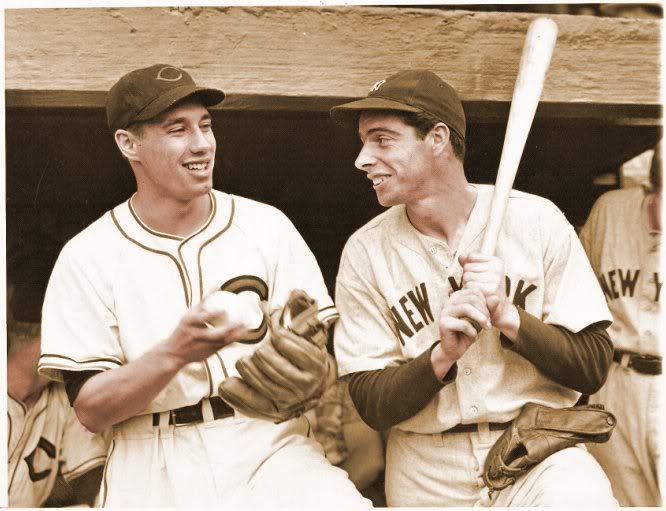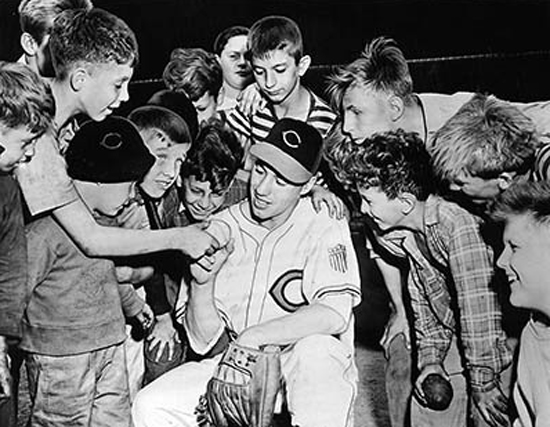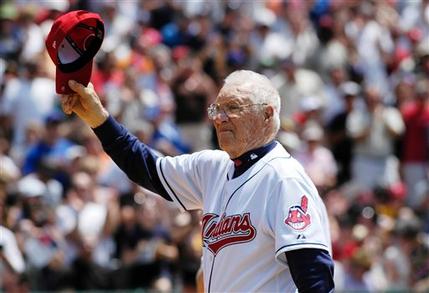 We are beginning a new series on the Indians, running through the 2012 season. It is a weekly look back at particular games in Tribe history. Games may be featured due to the stories that played out between the foul lines. Or, they may have been part of a larger story that is, or was, significant to Tribe fans. I’m pretty pumped about it, so let’s get started!
We are beginning a new series on the Indians, running through the 2012 season. It is a weekly look back at particular games in Tribe history. Games may be featured due to the stories that played out between the foul lines. Or, they may have been part of a larger story that is, or was, significant to Tribe fans. I’m pretty pumped about it, so let’s get started!
“Hey hon, I need an opening line for an article.”
My wife’s eyes rose to meet mine, her posture at the kitchen table held in a subtle, Sunday crossword lean. With a mischievous smile:
“It was the best of times, it was the worst of times, it was the age of wisdom, it was the age of foolishness, it was the epoch of belief, it was the epoch of incredulity, it was the season of Light, it was the season of Darkness, it was the spring of hope, it was the winter of despair, we had everything before us, we had nothing before us, we were all going direct to Heaven, we were all going direct the other way - in short, the period was so far like the present period, that some of its noisiest authorities insisted on its being received, for good or for evil, in the superlative degree of comparison only.”
“Nice, very nice. But I can’t plagiarize A Tale of Two Cities.”
 Her eyebrows lifted as she blinked. “What is the article about?”
Her eyebrows lifted as she blinked. “What is the article about?”
“Bob Feller’s no-hitter on Opening Day. It remains the only no-hitter ever pitched to start a season. Actually, your choice of the Dickens novel is interesting. The no-no was in 1940, when in Cleveland there was a huge separation between the haves and have-nots. Every city in the U.S. was still groaning through the Great Depression.”
She straightened up. “To the red country and part of the gray country of Oklahoma, the last rains came gently, and they did not cut the scarred earth.” She added a feminine, “Bam.” Like the kids do.
“Grapes of Wrath? Right era. But I can’t use that, either. I need something, though, to start it off.”
Now facing me directly, she began to feel the momentum. “In the beginning God created the heavens and the earth.”
Ha, a clever one, she. And she knows how to make me laugh. My thoughts turned to Genesis I. How cool is it for a text as ancient as the Bible to declare that God created light, and day, and night- and then after that, He formed the sun. Wouldn’t that have been counterintuitive to an author of 3500 years ago…
“Didn’t Bob Feller pass away recently?”
Sensing a baseball conversation, I nodded as I sat my coffee cup on the corner of the counter. “Yeah, and it seemed like he’d been around forever. I’ve always wanted to research and write about Feller, but to do him justice, the piece would need to be loooooong. And anyway, several nice bios are out there from when he died a little over a year ago. They have been done.
“But I thought if I took a look at some of Feller’s story in bite-sized portions, that could be manageable. Same thing with other Indians icons. Mel Harder. Rocky Colavito.”
“Grady.” She was only half-kidding. That’s cool. Following sports is for whatever you want it to be for.
I’d been doing a lot of reading on Feller, and his 1940 no- hitter in particular…
The opener was in Comiskey Park, against the White Sox. The legendary Chicago wind made the 30+ degree day seem much colder. The 21-year-old pitcher would maintain that his arm remained stiff throughout the game, and that he seldom pitched well early in the season anyway.
This day was true to form, as he would later note. In his mind, there was nothing special about the quality of his pitches. On the other hand, he would rave about the defensive support of his teammates.
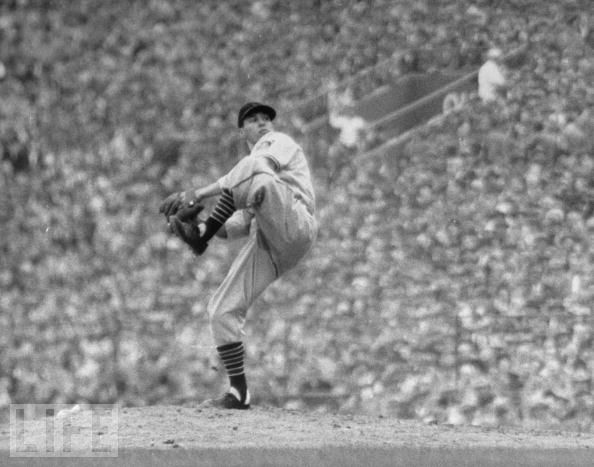
Bob Feller had been a 17-year-old righthanded phenom, famously signed out of Van Meter, Iowa. His ‘bonus’ was a handshake and a $1 bill. In his first start, he’d struck out 15 batters. A month later, he would tie the major league record, with 17. He famously threw faster than any pitcher in the history of baseball- later in his career, he was clocked at 104 miles per hour with military timing equipment. He would occasionally comment that he once threw a pitch that was recorded at over 107mph. Feller boasted a repertoire of various windups and motions, including overhand, three-quarters, and sidearm. And his curveball was wicked, especially to righthanded hitters- it came right at them before breaking over the plate.
On this day, however, the curve wasn’t working. Feller relied solely on the fastball from the second inning on.
With the game scoreless in the bottom of the 2nd , Chicago rightfielder “Taffy” Wright lofted a fly ball to center field. “Stormy” Weatherly was fooled by the wind and misjudged the ball. It dropped as Wright reached second base. (In the Plain Dealer the next day, Indians beat writer Gordon Cobbledick – no, really- left no doubt that Weatherly’s play was an error, by reasonable standards. Feller would one day admit that he received the benefit of the doubt from the official scorer. Regardless, nobody knew what the ramifications of that play would be, as it happened so early in the game.) After a strikeout, two walks followed to load the bases. Indians manager Ossie Vitt had a reliever warming in the bullpen but left Feller in the game as he recorded a strikeout for out number three.
The game remained scoreless into the 4th inning. Indians left fielder Jeff Heath- who also was Feller’s roommate- grounded a single to left. Third baseman Kenny Keltner flied out before catcher Rollie Hemsley sent one to right field. Taffy Wright misplayed the ball into a triple, and Heath crossed home plate.
In the late innings of the 1-0 game, the hometown White Sox fans became Bob Feller fans. Through the 8th inning and into the 9th, they held their collective breath and cheered every pitch.
Center fielder Mike Kreevich (pop up to 2nd) and left fielder Moose Solters (grounder to short) fell victim to Feller in the 9th inning. Up came Luke Appling. The White Sox shortstop was in the middle of his 20 year, Hall of Fame career. He was known as having the ability to foul off pitch after pitch, and that was what he was doing with Feller in the 9th. He crushed four foul balls down the right field line. Feller was tiring, and later admitted that since the count was 3 – 2 and he was having trouble putting Appling away, he walked him on purpose in order to face the next batter. Up came Taffy Wright.
Representing the tying run, 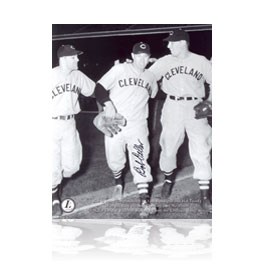 Appling bounced away from the first base bag. The fleet-footed shortstop had Feller’s attention. Feller’s second pitch to Wright was rocketed into the hole on the right side. Ray Mack, the Tribe second baseman, shot out into shallow right field and knocked the ball down. He scampered to it and whirled to throw it to first baseman Hal Trosky, and Wright was out by an eyelash. Many of the 14,000 in attendance dropped to the field, rejoicing and milling about. (Yes, 14,000. Opening day in Chicago. Weak. Several other venues attracted more fans that day, even more than double.) Photo on right captures Feller and teammates after the 1940 no-hitter.
Appling bounced away from the first base bag. The fleet-footed shortstop had Feller’s attention. Feller’s second pitch to Wright was rocketed into the hole on the right side. Ray Mack, the Tribe second baseman, shot out into shallow right field and knocked the ball down. He scampered to it and whirled to throw it to first baseman Hal Trosky, and Wright was out by an eyelash. Many of the 14,000 in attendance dropped to the field, rejoicing and milling about. (Yes, 14,000. Opening day in Chicago. Weak. Several other venues attracted more fans that day, even more than double.) Photo on right captures Feller and teammates after the 1940 no-hitter.
Bob Feller would note that Mack’s effort to end the game was the play of the game. Wright’s was the hardest hit ball of the day.
The Cleveland Plain Dealer would disclose that the team refrained from mentioning the term ‘no-hitter’ to Feller; by 1940, that was already a time-honored tradition (superstition): don’t mention it, or it will jinx the pitcher. Tribe players were buzzing after the game about the first base umpire, who in the 8th inning had openly discussed the fact that Chicago hadn't gotten a hit yet. (By the way, why does current Tribe announcer Tom Hamilton spoil the fun? He routinely violates this 'rule'. I love the guy, but come on, Tom!)
When the Indians returned to Cleveland, a marching band and 7,000 fans greeted Feller at Terminal Tower (ahem, that's half the number of fans that showed up to the game at Comiskey. On Opening Day.)
Feller's father, mother and sister had attended the opener. The pitcher knew he wouldn’t be around for Mothers’ Day or Fathers’ Day, so he hosted them at the opener in Chicago. So if they hadn’t been present, the attendance would have been 3 FEWER. HA.
1940 would not end as well as it had begun for the Cleveland Indians. They would bristle and revolt under Vitt, who never seemed to pass up an opportunity to publicly criticize his players. Most of the team approached ownership and asked that he be removed. They became known around the league as the Cleveland Crybabies, receiving insults and worse on the road- especially in towns like Detroit. Vitt reveled in the abuse of his players.
On an exponentially more serious note, Japan would bomb Pearl Harbor in a surprise attack in 1941. Bob Feller would be one of the first in a tidal wave of players to enlist in the U.S. military. He was Gun Captain aboard the USS Alabama.
Assuming an uninterrupted baseball career arc, Feller would likely have ended his career with 370+ wins, and all-time records in strikeouts and no-hitters. He did finish with 3 no- hitters- including one during his first full season after his return to the big leagues, in 1946.
War production began to pull the U.S. out of the Great Depression. Through the 1930s, cities had suffered from massive job layoffs. Cleveland was suffering from 30-40% unemployment in its steel industry, and its citizens were moving to rural areas to establish farms in the hopes of being able to feed their families. Public works projects were undertaken on a large scale as infrastructure was built and laborers were put to work.
Notably, the Great Lakes Exposition was held in Cleveland in 1936 and 1937. It was basically an industrial fair, along the lines of a World’s Fair. Municipal Stadium was the western anchor of the grounds. Stretching from East 9th Street to East 24th Street along the Cleveland lakefront, several gardens, art deco-inspired buildings, and lavish landscaping offered an impressive presence for local, national, and international visitors. Bands, orchestras, and patriotic pageants provided entertainment among such attractions as the “Streets of the World”, which was a carnival-style area with an international flavor. Another feature was Billy Rose’s Aquacade, which featured divers and swimmers such as Johnny Weissmuller. The Great Lakes Exposition was a worthy diversion during the Great Depression. There are plenty of great links that are easily found online.
By 1941, Adolph Hitler had been rising to power in Germany over the previous ten years, and had begun methodically conquering and occupying other European nations. Japan had started an on-again, off-again war with China over the previous decade as well. On December 7th, their attack on Pearl Harbor drew the United States into the war.
As Kurt Vonnegut would say, “All this happened, more or less.”
Thank you for reading.
Below, Feller with Joe DiMaggio. Feller said Ted Williams was the better hitter, but DiMaggio was the better all-around player.
